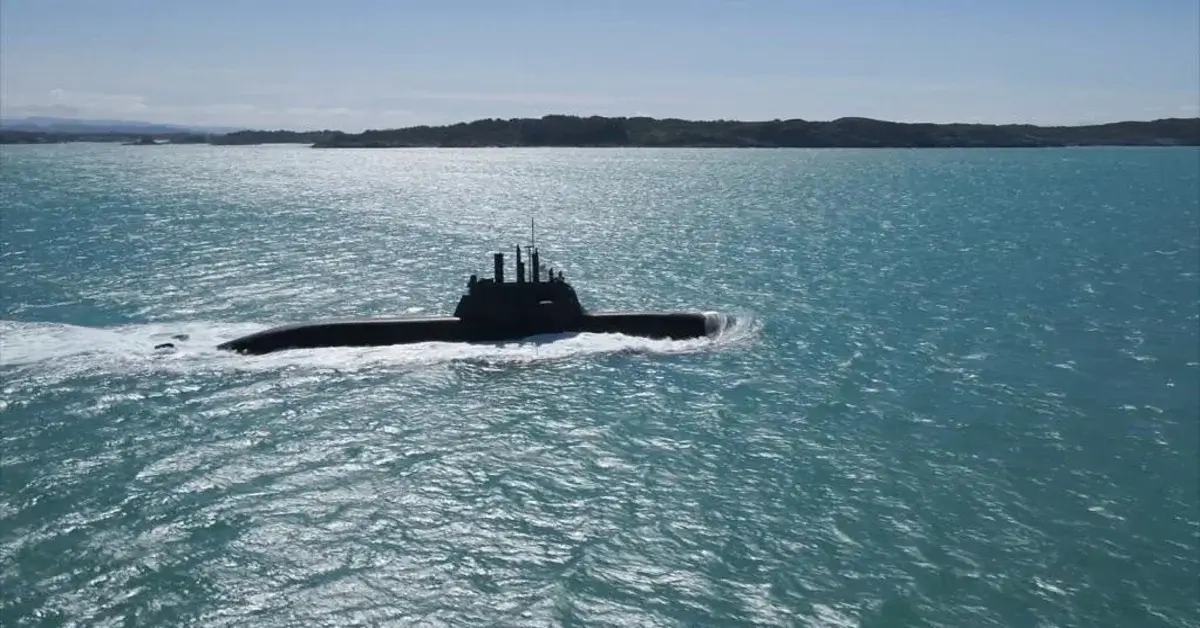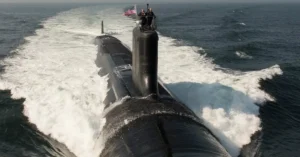How fast is a submarine? Submarines play a crucial role in the United States Navy, where speed and stealth are essential for their operations. This article will explore the top speeds of various submarine classes, from fast nuclear attack subs to other foreign vessels.
We’ll delve into how speeds have evolved over time and what capabilities different types of subs have. By the end, you’ll understand the true potential speeds of these incredible underwater machines.
Types of Submarines
We know submarines are incredible underwater vessels capable of diving deep into the ocean and traveling at considerable speeds. But do you ever wonder, “How fast is a submarine?” The answer lies in the different types of service submarines, each with distinct characteristics and purposes.
Attack submarines are designed to seek and destroy enemy submarines and surface vessels. Among the well-known attack submarines are the Seawolf, Los Angeles, and Virginia. The Seawolf class submarine can reach up to 35 knots (about 40 mph), while the Virginia class has a top speed of 25 knots (about 29 mph). The Los Angeles-class submarines share similar speeds with the Virginia class.
Ballistic missile submarines have a single strategic mission: carrying nuclear submarine-launched ballistic missiles. Their role is to act as a deterrent against potential enemy attacks by remaining hidden and ready to launch a counterstrike if necessary. However, ballistic missile submarines must also be fast enough to evade detection if needed. How fast is a submarine like this able to travel?
Guided missile submarines mainly serve to launch cruise missiles at land targets or enemy installations. While their primary purpose isn’t speed, these vessels must be highly mobile and stealthy to evade detection. How fast is a submarine of this type capable of maneuvering to avoid threats?
Another type of submarine relies on diesel-electric or air-independent propulsion systems. These submarines, such as the German Type 212, are generally slower than their nuclear counterparts, with a top speed of 20 knots (about 23 mph). However, even for these subs, speed remains an important factor in avoiding detection. How fast is a submarine powered by dieselelectric engines?
One of the prominent submarine manufacturers is General Dynamics Electric Boat, which is responsible for producing some of the most advanced nuclear-powered submarines for the United States Navy. These vessels are engineered with impressive underwater speed in mind.
The speed of a submarine depends on various factors, such as its propulsion system, hull design, and mission requirements. Submarines like the Seawolf and Virginia classes are designed for swift and stealthy operations, while others, like ballistic missile submarines, prioritize stealth and endurance over outright speed. But in all cases, how fast is a submarine really capable of traveling while maintaining stealth?
Regardless of their top speed, all modern submarines incorporate cutting-edge technology to fulfill their critical roles in naval warfare. Speed continues to influence submarine design and capabilities.
Submarine Speed and Propulsion

Ever wondered how fast is a submarine? Many factors contribute to the speed of these stealthy underwater vessels, ranging from the type of propulsion systems to the design of their bodies. In this section, we’ll explore the velocities commonly achieved by submarines and the technology that enables these impressive waterborne machines.
Submarine speed is typically measured in knots, with 1 knot equaling 1.852 km/h or 1.15 mph. Some of the fastest submarines on the planet include the Russian Navy’s Akula-class and the United States Navy’s Seawolf-class submarines.
These nuclear-powered vessels can reach top speeds of over 35 knots (65 km/h or 40 mph), allowing them to cover vast distances quickly and discreetly.
Design and construction also play critical roles in determining submarine speed. Inefficiencies caused by exposed components plagued early submarine designs and hulls not explicitly designed for underwater use.
However, advancements in submarine design, such as the sleek German Type XXI submarines of World War II, significantly improved submerged speed capabilities. Modern submarines boast smooth exteriors and streamlined hulls, minimizing drag and allowing them to travel more efficiently underwater.
Cutting-edge research in submarine propulsion includes the development of next-generation propulsors, which aim to enhance speed and efficiency even further. Additionally, some countries are exploring alternative energy sources, like lithium-ion batteries, to improve the performance and capabilities of their submarines.
In conclusion, submarine speed is a fascinating and complex topic. As technology advances and new systems are developed, we can expect submarines to become even faster and more efficient, allowing them to continue serving pivotal roles in naval operations worldwide.
Weapons and Defensive Systems

As we explore the fascinating world of submarines, we often wonder how fast is a submarine. However, speed is just one aspect of their capabilities. Another crucial aspect of submarines is their weapons and defensive systems. Let’s delve into the various systems that make these underwater vessels formidable.
Submarines are equipped with various weapons, including torpedo tubes, designed to launch torpedoes at enemy ships and submarines. The tubes can also be used to launch Tomahawk cruise missiles at land-based targets. The Tomahawk Land Attack Missile is a long-range, all-weather, subsonic cruise missile that has been vital to submarine warfare for many years.
Most modern submarines also boast payload tubes. These tubes have a versatile multi-purpose design, enabling them to host different types of weaponry. For instance, they can hold the versatile Tomahawk cruise missiles adept at targeting land-based and maritime targets. Additionally, they might carry mines which can be deployed discreetly to disrupt enemy operations.
Lastly, the Mk 48 torpedo is critical to many submarines’ arsenal. This heavyweight torpedo is designed to sink deep-diving, high-performance submarines and surface ships. Its advanced guidance system and lethal warhead make it a formidable weapon in modern submarine warfare.
To sum up, submarines possess impressive speed and stealth characteristics and are equipped with advanced weapons and defensive systems. Combining the cutting-edge technology with the deterrence power of torpedoes, missiles, and mines, they remain crucial assets to navies worldwide.
Features and Innovations

When considering how fast a submarine is, it’s essential to consider the multiple features and innovations contributing to its speed, efficiency, and overall performance. This section will discuss some critical aspects that make modern submarines incredibly advanced and versatile.
One of the crucial innovations in submarine technology is the development of advanced sonar systems. These systems enable submarines to navigate, communicate, and detect other vessels. The Large Aperture Bow (LAB) Array is an example of such a system, which significantly enhances the detection capabilities of the submarine.
Another essential innovation is the use of photonics masts instead of traditional periscopes. These masts feature high-resolution cameras, infrared sensors, and other electronic devices, which enable the crew to see above the water’s surface without having to surface the submarine.
Modular construction and open architecture are two approaches that have been adopted in the design of modern submarines. These methods allow for more flexibility in integrating new technologies and systems and the ability to upgrade existing components more quickly. Adopting commercial off-the-shelf components further streamlines the upgrade process and reduces costs.
Submarines’ ability to operate beneath the ice is mainly due to their diving planes, which allow them to control their depth and maintain a stable position under the water. This is a crucial feature for submarines designed for missions in the Arctic and Antarctic regions.
In conclusion, the advancements in submarine technology are wider than how fast a submarine can travel. Innovations like sonar systems, photonics masts, modular construction, and versatile payload systems all contribute to these remarkable vessels’ overall efficiency and capabilities.
As we explore how fast a submarine is, it’s essential to delve into the various roles and missions they serve.
Roles and Missions

Today’s submarine force is the epitome of technological superiority, with multi-mission platforms designed to carry out diverse tasks in the ocean’s depths. Standard submarine missions protect the United States Navy’s surface fleet, intelligence gathering, and maintaining potent nuclear deterrent arsenals. The U.S. submarine force comprises three major types: SSBN, SSGN, and attack submarines, which are all nuclear-powered.
Attack submarines, on the other hand, have various tactical missions like sinking enemy ships and submarines, enabling them to protect and ensure the safety of our surface fleet. They play an essential role in maintaining a balance of power underwater and aid in collecting critical intelligence.
A submarine’s ability to execute these missions depends on the skill and training of submariners who undergo rigorous preparation and understanding of the vessel and its systems. Their dedication and expertise are crucial in ensuring that each mission carried out by the submarine is successful.
Moreover, submarines serve as a platform for classified research and development, leveraging their inherent stealth and ability to navigate undetected to support scientific advancements and new technologies. The combination of cutting-edge technology, skilled submariners, and diverse mission capabilities underline the importance of submarines in our modern naval strategy.
Historical Context and Future Directions

As we explore how fast is a Submarine, it’s essential to understand the historical developments and future directions of submarine technology. From their introduction during World War I to their continued evolution, submarines have played a crucial role in naval warfare.
Submarines first gained prominence in World War I, used by Germany to destroy surface merchant vessels. Their role as a crucial weapon was solidified during World War II when they proved invaluable in both the Atlantic and Pacific theaters. The attack on Pearl Harbor demonstrated the strategic significance of submarines, as Japanese submarines played a part in the infamous event.
Over the years, different classes of submarines have been developed, each with its own capabilities and speed limitations. The Los Angeles-class submarines, for example, can reach speeds of more than 30 knots (34.5 mph). In contrast, the newer Virginia-class submarines are known for their stealth and advanced technology and can achieve similar speeds.
The Seawolf-class submarine represented a significant technological advancement but was costly to produce, resulting in a limited number of these vessels. However, the lessons learned from Seawolf’s development contributed to the more cost-effective Virginia-class submarines. Another noteworthy submarine is the Barracuda, a French nuclear-powered attack submarine designed for various mission types and capable of reaching 25 knots (28.7 mph).
Record-breaking submarines demonstrate the progress made in submarine technology. Additionally, the USS Jimmy Carter, a modified Seawolf-class vessel, further showcases advancements in versatility and operational ability.
The Naval Sea Systems Command and the U.S. Submarine Force are consistently working to develop new, cutting-edge technologies in undersea warfare. As we look to the future of submarines, it’s clear that the pursuit of increased speed, stealth, and operational capacities will drive further advancements, pushing the boundaries of the already impressive capabilities of these undersea vessels.
FAQ – How Fast Is a Submarine?
One common question arises when discussing submarines: how fast is a submarine? In this section, we will address some frequently asked questions that provide information about the speed of Submarines and will help you to understand more about Submarines.
How fast is a submarine in mph?
The speed of a submarine can vary depending on the type and power source. Generally, non-nuclear submarines like the German Type 212 submarine have a top speed of 20 knots.
What is the world’s fastest submarine?
The exact speed of the world’s fastest submarine is not publicly available. However, it is widely believed that Russian Akula class submarines are among the most rapid, with designers stating they can reach speeds faster than 35 knots.
Is A submarine faster than a boat?
Submarines can be faster than some boats, but not all. Generally, high-performance speedboats can reach speeds much more significant than a submarine. Submarines prioritize stealth, endurance, and maneuverability over speed, while boats mainly focus on speed and efficiency.
Do submarines travel faster above water?
Submarines usually travel slower when surfaced compared to their underwater speed. The reason behind this is the hydrodynamic shape of a submarine, which is designed for optimal underwater performance. Additionally, when surfaced, submarines need to operate their diesel engines, which might not provide the same level of propulsion as their nuclear or AIP systems when submerged.
We hope you find our article on “How Fast Is a Submarine?” interesting and informative. We would appreciate hearing your thoughts on the content. Please feel free to share any experiences and notions you have had in the comments section below.









